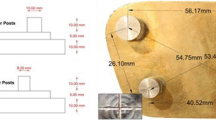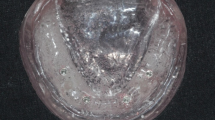Abstract
Impressions are important sources of cross contamination between patients and dental laboratories. As a part of infection control impressions contaminated with variety of micro-organisms via blood and oral secretions should be cleaned and disinfected or sterilized before being handled in dental laboratory. The purpose of this study was to determine the effect of autoclaving on dimensional stability of elastomeric impression material (polyvinyl siloxane—Affinis). In this in vitro study standardized stainless steel die as per ADA specification number 19 was fabricated. Polyvinyl siloxane (Affinis) light body and putty viscosity elastomeric impression materials were used. A total of 40 impressions of the stainless steel die were made and numeric coding system was used to identify the samples. Measurements were made using a measuring microscope. Distance between the cross lines CD and C′D′ reproduced in the impression were measured before autoclaving, immediately after autoclaving and 24 hours after autoclaving and dimensional change was calculated. The data obtained was subjected to statistical analysis. The mean difference in dimensional change between the three groups was not statistically significant (P > 0.05). However the results revealed that there was higher mean dimensional change immediately after autoclaving when compared to the other 2 time intervals. It is desirable to delay the casting of an autoclavable elastomeric impression material by about 24 hours. Though disinfection of impression is routinely followed autoclaving of impression is an effective method of sterilization.




Similar content being viewed by others
References
Krygier G (1999) Infection control in dental practice, 1st edn. All India Traveller Book Seller, India
Reports of Councils and Bureaus—Revised (1977) ADA specification No 19 for non aqueous elastomeric impression materials. JADA, vol 94, April 1977
Thouati A (1996) dimensional stability of seven elastomeric impression materials immersed in disinfectants. J Prosthet Dent 76:8–14
Johnson GH (1998) Dimensional stability and detail reproduction of irreversible hydrocolloid and elastomeric impression disinfection. J Prosthet Dent 79:446
Adabo G (1999) Effect of disinfectant agents on dimensional stability of elastomeric impression materials. J Prosthet Dent 81:621–624
Walker MP (2007) Surface quality and long term dimensional stability of current elastomeric impression materials after disinfection. J Prosthodontics 16:343
Rios MDP (1996) Effects of chemical disinfectant solutions on the stability and accuracy of the dental impression complex. J Prosthet Dent 76:356
www.coltenewhaledent.com. Accessed March 2010
Author information
Authors and Affiliations
Corresponding author
Rights and permissions
About this article
Cite this article
Surendra, G.P., Anjum, A., Satish Babu, C.L. et al. Evaluation of Dimensional Stability of Autoclavable Elastomeric Impression Material. J Indian Prosthodont Soc 11, 63–66 (2011). https://doi.org/10.1007/s13191-011-0061-1
Received:
Accepted:
Published:
Issue Date:
DOI: https://doi.org/10.1007/s13191-011-0061-1




